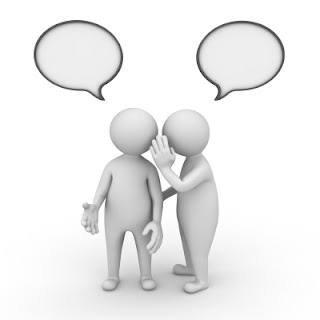Crafting Great Dialogue
By Andrea Merrell
 A speaker tag shows the speaker’s name and a speech-related verb (said, asked, shouted). This is generally the best way to show which of your characters is speaking, but sometimes we tend to overuse them. They're not necessary each and every time someone speaks, especially in a long section of dialogue.
A speaker tag shows the speaker’s name and a speech-related verb (said, asked, shouted). This is generally the best way to show which of your characters is speaking, but sometimes we tend to overuse them. They're not necessary each and every time someone speaks, especially in a long section of dialogue.
 Note: Just like the speaker tags, don’t overuse beats. Too many will interrupt the flow of dialogue. They're not necessary every time but work well to help set the scene when used correctly. You can also use them at the beginning instead of the end:
Note: Just like the speaker tags, don’t overuse beats. Too many will interrupt the flow of dialogue. They're not necessary every time but work well to help set the scene when used correctly. You can also use them at the beginning instead of the end:
Dialogue can make or break a story—too much, too little, too stilted, or too corny.
When we read, we want to see the characters interacting with each other. Whether they're arguing, sharing secrets, or just getting to know each other, we want the communication to be real and flow in such a way that we get pulled into the story.
As writers, we all have a unique voice. When we create our characters, they will also have a voice. The problem occurs when all of our characters have our voice instead of their own. How boring for our readers if everyone in our story sounds the same.
Tips To Remember When Crafting Dialogue
- Use believable, down-to-earth dialogue that fits your character.
- Don’t be afraid to use contractions, since that’s the way most people talk.
- Be mindful of the setting, especially if it’s historical.
- Make your words fit the culture.
- Consider the age of your characters.
Using speaker beats and tags will enhance your dialogue. Let’s look at both.
Speaker Tags
 A speaker tag shows the speaker’s name and a speech-related verb (said, asked, shouted). This is generally the best way to show which of your characters is speaking, but sometimes we tend to overuse them. They're not necessary each and every time someone speaks, especially in a long section of dialogue.
A speaker tag shows the speaker’s name and a speech-related verb (said, asked, shouted). This is generally the best way to show which of your characters is speaking, but sometimes we tend to overuse them. They're not necessary each and every time someone speaks, especially in a long section of dialogue.
Example: “That’s a lovely dress you’re wearing,” Wendy said.
“Thank you so much,” Beverly replied.
“Would you tell me where you got it?” Wendy said.
“Sure. It came from Dillard’s,” Beverly answered.
Do you see how annoying that could get?
Note: This is a common error when using speaker tags: “That’s a pretty scrawny dog,” Jim laughed. Since Jim cannot laugh that comment, the proper way would be: “That’s a pretty scrawny dog.” Jim laughed. Do you see the difference? In the second example, there is a period after the word dog instead of a comma. The problem with this is that the second example now becomes a speaker beat instead of a tag.
Speaker Beats
A speaker beat describes the action that accompanies what the speaker is saying (like the example above). Here is another example:
“I can’t believe you said that to me.” Jessie grabbed her keys and headed for the door.
 Note: Just like the speaker tags, don’t overuse beats. Too many will interrupt the flow of dialogue. They're not necessary every time but work well to help set the scene when used correctly. You can also use them at the beginning instead of the end:
Note: Just like the speaker tags, don’t overuse beats. Too many will interrupt the flow of dialogue. They're not necessary every time but work well to help set the scene when used correctly. You can also use them at the beginning instead of the end:
Jessie grabbed her keys and headed for the door. “I can’t believe you said that to me.”
Know your characters well and present them in such a way your readers will not forget them.
What secrets can you share about crafting dialogue? We would love to hear your suggestions.
What secrets can you share about crafting dialogue? We would love to hear your suggestions.
(Photos courtesy of FreeDigitalPhotos.net/cooldesign/Master Isolated Images.)
TWEETABLES




Great job on dialog, Andrea. Thanks and I'm going to share it!
ReplyDeleteHugs,
Elva Cobb Martin,
Pres. ACFW-SC Chapter www.elvamartin.com
Thanks so much, Elva! :)
Deletei love writing dialogue! especially the nuance of each character, as you said, age, historical era, mood, etc. the actress in my really shines and helps me create some great dialogue if i do say so myself!
ReplyDeleteGreat to hear, Robin. Dialogue makes the story come alive. Thanks for sharing. :)
DeleteGreat post, Andrea. I am just starting to dabble in flash fiction and short fiction stories. This is very helpful as I don't know a lot about dialogue. Thanks for sharing!
ReplyDeleteThanks, Sheryl. The more you practice, the better you'll become. Read your words out loud when you proof, and see if they resonate with you. Blessings. :)
DeleteI know when when to use beats versus tags? Is there a general rule?
ReplyDeleteEllen, the main thing is using variety, mixing them up and not overusing either one. The tags (or speaker attributions) are primarily to let the reader know who's speaking. When you use the speaker beats (or action beats), you are showing the reader what's taking place while the dialogue is going on. Just be sure the beat goes with the proper person. Sometimes writers will write a line of dialogue and then put the speaker beat on another line. This confuses the reader. Does that help? Blessings! :)
Delete